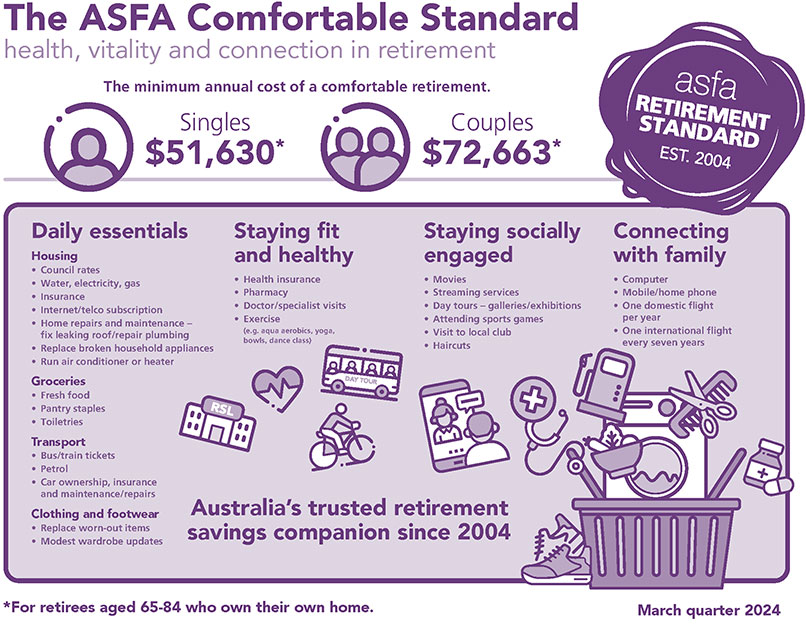Loading component...
At a glance
For people aged 50 and over, there is a question that supersedes politics and property as the go-to talking point at dinner parties: what superannuation balance is sufficient for a “comfortable” retirement?
Cost-of-living pressures, longer life expectancies and gender pay gap issues are adding layers of complexity to an already difficult equation in Australia, while 2024 has seen various changes to superannuation.
Retirement planning
The sum needed for retirement can vary dramatically depending on a person’s desired lifestyle and how long they expect to live.
CPA Australia’s superannuation lead Richard Webb notes an Organisation for Economic Co-operation and Development figure that suggests a replacement retirement income ratio of about 70 per cent for average earners to maintain their pre-retirement living standards.
“Of course, it’s a subjective thing,” Webb says. “Everyone’s going to have their own standards for retirement.”
While the Grattan Institute has also adopted 70 per cent as the target replacement income ratio, Treasury’s Retirement Income Review final report in 2020 opted for a range, noting that “the suggested benchmark replacement rate is 65–75 per cent”.
Savings targets and budgeting
To provide some clarity for retirees, Super Consumers Australia has updated its retirement savings targets to reflect recent cost-of-living spikes and a rise in the government Age Pension.
In conducting the forecast, the consumer advocacy group sought to assess what people really wanted in retirement, with many commenting that they were seeking to maintain a similar standard of living as in their pre-retirement years.
When it comes to determining the final figures, Super Consumers Australia founder and director Xavier O’Halloran says that “the key part is that we also wanted to look at whether people were actually happy or not”.
Super Consumers Australia has suggested a range of retirement savings targets (see Table 1) that differ depending on current age, living arrangements and how much the retiree wants to spend each year.
At the lower end, low-spending singles aged 65–69 years need about A$76,000 in their super balance. At the higher end, couples aged 65–69 who want a more comfortable lifestyle need about A$1.055 million.
| Current age | Living arrangement | Spending in retirement (A$) | Amount to save by age 65 (A$) | |
|---|---|---|---|---|
| Per fortnight | Per year | |||
| 55–59 years, pre retirement, will own home by the time of retirement | Single | 1385 | 36,000 | 91,000 |
| 1808 | 47,000 | 317,000 | ||
| 2269 | 59,000 | 777,000 | ||
| Couple | 2000 | 52,000 | 116,000 | |
| 2654 | 69,000 | 425,000 | ||
| 3346 | 87,000 | 1,037,000 | ||
| 65–69 years, already retired, will own home by the time of retirement | Single | 1192 | 31,000 | 76,000 |
| 1577 | 41,000 | 279,000 | ||
| 2115 | 55,000 | 795,000 | ||
| Couple | 1692 | 44,000 | 95,000 | |
| 2308 | 60,000 | 371,000 | ||
| 3077 | 80,000 | 1,055,000 | ||
O’Halloran notes that the targets assume that the person or couple will own their home outright by the time of retirement and that the targets may be lower than expected, because they account for partial Age Pension payments for those who are eligible.
The Association of Superannuation Funds of Australia (ASFA) issues its own set of financial targets for retirement, known as The ASFA Retirement Standard.
The standard estimates the superannuation balances required for both a modest and a comfortable lifestyle in retirement at age 67 (see Table 2), ranging from A$100,000 for a modest lifestyle for singles to $690,000 for couples who want a comfortable lifestyle.
| Living arrangement | Lifestyle | Superannuation balance needed for retirement at age 67 (A$) |
|---|---|---|
| Single | Modest | 100,000 |
| Comfortable | 595,000 | |
| Couple | Modest | 100,000 |
| Comfortable | 690,000 |
In addition, for the March quarter of 2024, the standard provides yearly budgets by age (see Table 3). It also provides a detailed spending breakdown.
| Age | Living arrangement | Lifestyle | Budget for spending in retirement (per year, A$) |
|---|---|---|---|
| 65-84 years | Single | Modest | 32,915 |
| Comfortable | 51,630 | ||
| Couple | Modest | 47,387 | |
| Comfortable | 72,663 | ||
| Around 85 years | Single | Modest | 30,669 |
| Comfortable | 48,075 | ||
| Couple | Modest | 43,891 | |
| Comfortable | 67,050 |
ASFA defines a comfortable retirement as one that lets retirees maintain a good standard of living in their post-work years, accounting for essentials “such as groceries, transport and home repairs, as well as private health insurance, exercise and leisure activities and the occasional restaurant meal” (see Figure 4).

Increase to Age Pension
One prominent obstacle with retirement planning is that no one knows how long they will live once they have retired.
The Australian Bureau of Statistics puts the life expectancy of women at 85.3 years and men at 81.2 years.
Webb says the matter of longevity will only get more complex as people need their finances to stretch even further.
“Most of us would expect that as medical science improves, it means that people are going to live longer,” he adds.
“Fortunately, the Age Pension provides a considerable buffer for retirees,” says Mary Delahunty, CEO of ASFA.
The Australian Government raised the Age Pension in March 2024 by A$19.60 a fortnight for singles, and A$29.40 a fortnight for couples combined, making the new maximum pension rate A$1116.30 per fortnight for singles and A$1682.80 for couples (see Table 5).
| Payment | Amount per fortnight | |||
|---|---|---|---|---|
| Single | Couple each | Couple combined | Couple apart due to ill health | |
| Age pension - maximum basic rate | 1020.60 | 769.30 | 1538.60 | 1020.60 |
| Maximum Pension Supplement | 81.60 | 61.50 | 123.00 | 81.60 |
| Energy Supplement | 14.10 | 10.60 | 21.20 | 14.10 |
| Total | 1116.30 | 841.40 | 1682.80 | 1116.30 |
“The Age Pension will do a lot of the heavy lifting to cover inflationary pressures, as it is indexed to help account for these cost increases twice a year,” O’Halloran says.
“This provides some comfort that people won’t be completely left behind as inflation has an impact.”
Delahunty says there is no doubt that “uncertainty about longevity and variability in investment returns” can be challenging for retirees, but cutting back on expenditure when investment returns are lower can help retirees deal with investment return volatility.
For those who want more protection regarding the financial consequences of longevity, there may be options for financial protection.
“It’s important that people talk to their super fund or financial adviser about what is available and what might be suitable,” Delahunty says.
Women at a disadvantage
A further complication is that research has consistently shown that women in Australia tend to retire with less superannuation than men.
According to findings from the Australia Institute’s Centre for Future Work, women in Australia earn A$1 million less on average over their lifetimes than men and retire with A$136,000 less in superannuation.
HESTA chief executive Debby Blakey says that although Australia’s super system is among the world’s best, gaps remain that overwhelmingly disadvantage women and low-income earners.She points out that women face “unique retirement challenges, such as early retirement, longer lifespans and lower super balances”.
“Additionally, women are more likely to take extended breaks from work for caregiving duties, missing out on employer super contributions,” Blakey says.
At the same time, Blakey argues that it is important to “debunk the misconception” that a hefty retirement-savings sum, such as A$1 million or even A$500,000, is necessary for a comfortable retirement.
“This belief can discourage many, especially women and those with lower incomes, from actively managing and engaging with their superannuation. Instead, the emphasis should be on achievable steps to gradually build financial security,” Blakey explains.
Blakey believes individuals can “make significant strides towards their retirement goals” via regular contributions to super, employer contributions and exploring suitable investment options.
“By shifting the focus from daunting end goals to manageable steps and fostering financial confidence, individuals can take control of their retirement planning and work towards a more comfortable future,” she says.
Webb adds that the financial outlook is especially challenging for single women with children. For couples, however, some super strategies can potentially help boost women’s balances.
For example, contribution splitting is a financial strategy that allows super members to distribute certain before-tax contributions to their spouse’s super account.
The approach is designed to even out super balances between partners and is one solution that women have used effectively to achieve more balanced retirement savings.
Webb says it is also a positive that the Australian Government is acting on advocacy from CPA Australia and other groups to introduce paid superannuation for government-funded parental leave, which chiefly assists women. However, more needs to be done.
“A lot of the disadvantage for women has originated outside of superannuation,” Webb says.
O’Halloran agrees that women, in particular, face “structural problems” that have hurt their super outcomes, but potential measures they can take to improve their super nest egg include:
- making extra contributions where possible
- considering options such as the Home Equity Access Scheme, which allows people to turn part of their home equity into income
- focusing on super earlier in life
- having longer investment horizons.
“However, I really want to stress that this is a structural problem that individuals can’t always solve on their own,” O’Halloran says.
Digital tools to the fore
As people seek help and guidance for retirement planning, new tools are emerging.
HESTA’s Debby Blakey says there has been surging interest in the use of digital tools such as superannuation calculators and the group’s Future Planner digital help and education tool, which supports members as they consider their lifestyle goals and set long-term financial goals.
“By providing trusted guidance through channels that suit their needs, such as digital platforms, we aim to support our members to take control of their financial futures,” Blakey says.
She says the changing dynamics of relationships and increasing life expectancy have profound implications for women’s financial security, particularly in retirement planning. The trend of “grey divorce” – with one in three divorcing couples now being over 50 years – is having a significant impact on how women approach their financial futures.
“This trend has led to a concerning rise in homelessness among women over 55, highlighting the urgent need for a more comprehensive approach to retirement planning.”
With superannuation being the only independent source of financial security for many women, it clearly plays a vital role in their retirement planning. To that end, HESTA says it is crucial for women seeking to boost their super to factor in the three Cs: consolidate, contribute and check:
- Consolidating accounts can help reduce fees, although it is important to review any insurance coverage before doing so.
- Additionally, contributing extra funds regularly, for example through salary sacrificing, can significantly boost super over time.
- Regularly checking your insurance coverage and investment choices to align with your goals and risk tolerance is vital, especially as retirement approaches and priorities shift.
“However, it is essential to remember that these are general suggestions,” Blakey says.
“Personal goals, financial circumstances and specific needs should be carefully considered, and seeking advice from a financial adviser might be beneficial.”

